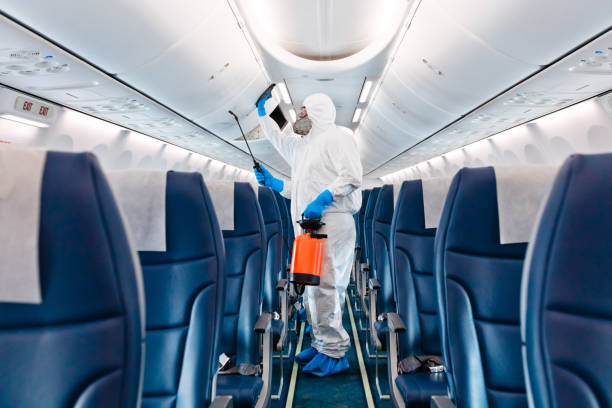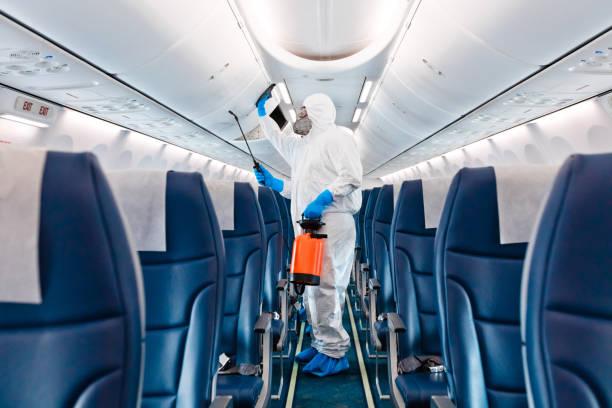Challenges and Solutions in Cleaning Large-scale Transport Fleets: Trains, Buses, and Airplanes

Introduction
Cleaning large-scale transport fleets, including trains, buses, and airplanes, presents unique challenges due to their size, complexity, and the need for efficient turnaround times. In this blog post, we will explore the specific challenges faced in cleaning these modes of transport and discuss innovative solutions that ensure cleanliness, hygiene, and passenger satisfaction.
-
Size and Accessibility
One of the primary challenges in cleaning large-scale transport fleets is their sheer size. Trains, buses, and airplanes consist of multiple compartments, intricate interiors, and hard-to-reach areas. Cleaning crews must navigate through narrow aisles, reach high ceilings, and clean various surfaces effectively. The size and complexity of these vehicles require specialized equipment, such as extendable cleaning tools and adjustable ladders, to ensure thorough cleaning in all areas.
-
Time Constraints and Turnaround Efficiency
Transport fleets have tight schedules and limited downtime for cleaning. Quick turnaround times are crucial to ensure that vehicles are ready for the next departure. Cleaning crews must work efficiently without compromising on cleanliness and hygiene standards. Implementing streamlined processes, optimizing cleaning workflows, and utilizing efficient cleaning techniques are vital to meet these time constraints while maintaining high standards of cleanliness.
-
Sanitization and Hygiene Standards
Maintaining high levels of sanitization and hygiene is of utmost importance in transport fleets to ensure passenger safety and well-being. Buses, trains, and airplanes are enclosed spaces where germs can easily spread. Effective disinfection measures must be implemented, focusing on high-touch areas such as seats, armrests, handrails, and tray tables. The use of suitable disinfectants, regular cleaning schedules, and adherence to industry standards are critical in meeting stringent sanitization requirements.
-
Specialized Cleaning Challenges for Each Mode of Transport
While there are shared challenges, each mode of transport also presents unique cleaning considerations. Trains, for example, often have carpeted floors that require specialized cleaning methods to remove dirt and stains effectively. Buses may have fabric seats that need regular deep cleaning to maintain freshness. Airplanes pose challenges due to restricted space, complex ventilation systems, and the need for thorough disinfection. Tailoring cleaning techniques and approaches to the specific requirements of each mode of transport is essential for optimal cleaning outcomes.
-
Eco-Friendly Cleaning Solutions
With the increasing emphasis on sustainability, implementing eco-friendly cleaning solutions is crucial in the cleaning of large-scale transport fleets. Choosing environmentally friendly cleaning products and techniques minimizes the impact on the environment while ensuring passenger safety and cleanliness. Additionally, adopting sustainable waste management practices, such as recycling and reducing chemical usage, contributes to a greener and more responsible cleaning approach.
-
Staff Training and Retention
Maintaining a well-trained and motivated cleaning staff is vital for the success of cleaning operations in large-scale transport fleets. Comprehensive training programs should be implemented to equip cleaning crews with the knowledge of specific cleaning techniques, handling specialized equipment, and following safety protocols. Regular refresher courses and opportunities for professional cleaning development not only enhance cleaning skills but also contribute to staff retention and job satisfaction.
-
Technological Innovations
Technological advancements are revolutionizing the cleaning of large-scale transport fleets. Robotics, automation, and smart cleaning systems offer efficient and effective solutions. Robotic cleaners can navigate and clean the interiors of buses, trains, and airplanes, reducing human labor and ensuring consistent cleaning results. Automated systems, equipped with sensors and timers, enable precise and targeted cleaning while optimizing resource usage.
Conclusion
Cleaning large-scale transport fleets is a challenging task that requires careful consideration of size, accessibility, time constraints, hygiene standards, and mode-specific requirements. By implementing innovative solutions, such as specialized equipment, streamlined processes, eco-friendly cleaning practices, staff training, and technological advancements, the cleaning industry can effectively address these challenges and provide passengers with safe, clean, and comfortable transportation experiences. Embracing these solutions ensures passenger satisfaction, enhances operational efficiency, and upholds the reputation of transport companies in delivering exceptional cleaning standards.
